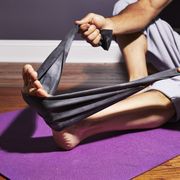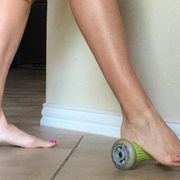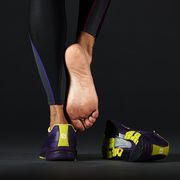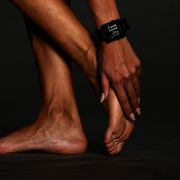If you’re running with plantar fasciitis, you’re likely not alone on the road. As the most common cause of pain at the bottom of the heel, according to The American Academy of Orthopaedic Surgeons, this injury plagues lots of people who are constantly on their feet—including runners.
Several culprits can make plantar fasciitis pop up, including drastically or suddenly increasing mileage, specific foot structures, and the wrong running shoes. All of these causes can overload the plantar fascia—the connective tissue that runs from your heel to the base of your toes—resulting in heel pain. To help you sidestep this common ache, here’s what to know about running with plantar fasciitis, including how to recognize it, treat it, and prevent it from happening again.
What is Plantar Fasciitis?
The plantar fascia is a tissue that looks like a series of fat rubber bands and extends from the heel toward the toes, along the arch of the foot. It’s made of collagen, a rigid protein that’s not very stretchy. The stress of overuse, overpronation, or overused shoes can rip tiny tears in it the plantar fascia tissue, causing heel pain and inflammation—that’s plantar fasciitis.
Identifying Plantar Fasciitis Symptoms
Those who suffer from plantar fasciitis feel a sharp stab or deep ache in the heel or along the arch of the foot, according to Jordan Metzl, M.D. and sports medicine physician at the Hospital for Special Surgery in New York City.
Another telltale sign of the condition: You feel pain as soon as you put your foot on the ground in the morning. The morning hobble you may experience comes from your foot trying to heal itself in a contracted position overnight. Taking that first step out of bed causes sudden strain on the bottom of your foot, resulting in pain in your heel or arch. The pain can recur after long spells of sitting, but it tends to fade during a run once the area is warmed up.
A third symptom those running with plantar fasciitis might experience is pain during push off while hitting your stride.
Common Causes of Plantar Fasciitis
Plantar fasciitis-related heel pain tends to strike those who overtrain, neglect to stretch their calf muscles, or overdo hill workouts and speed intervals. “When you have very tight calf muscles, they will pull on the plantar fascia and cause a lot of pain,” Metzl says.
A sudden increase in training mileage or a quick uptick in sprint training means you overwork the muscles when they're not quite ready, which can lead to conditions like plantar fasciitis.
Gear is super important too. Wearing old running shoes or constantly running on hard surfaces like asphalt or concrete can increase your risk of the condition. And to top it off, wearing high heels all day and then switching into flat running shoes may also increase your chances of heel pain from plantar fasciitis.
Finally, biomechanical issues may also cause plantar fasciitis. Those issues include high arches or flat feet or even excessive pronation.
The Best Plantar Fasciitis Treatment
Plantar fasciitis can be a nagging problem, which gets worse and more difficult to treat the longer you have it. So it’s best to address the issue as soon as you feel pain.
“When the fascia comes off the bone, it gets chronically inflamed and can heal exceptionally slowly,” Metzl says. “Plantar fasciitis can be sore for months because the healing response is proportionate to blood flow. When something has a good blood supply like a muscle, it heals quickly, but the plantar fascia essentially has no blood supply so it can take longer to heal.”
The first step in treating plantar fasciitis is to reduce swelling. Metzl recommends sticking your foot in an ice bucket or freezing a bottle of water and rolling your foot on top of it. You can also massage your foot with a golf ball.
Quite a few studies back up the benefits of using myofascial release (think: foam rolling or self massage) to help address plantar fasciitis pain—though there isn’t a consensus on the perfect myofascial program yet. Research also shows that stretching (particularly the plantar fascia itself, but also the calves) can help to alleviate the aches associated with the condition.
While the running shoes you choose are important—you don't want to wear a worn-out pair or one that doesn’t support your gait—what shoes you wear when you’re not clocking miles also matters. The key feature to look for in all shoes is arch support. And keep in mind that walking around barefoot or in flimsy shoes can delay recovery.
When to See a Doctor About Plantar Fasciitis
If pain is present for more than a couple weeks, see a medical professional about the problem. Your doctor might suggest treatment options such as orthotics, foot taping, cortisone injections, night splints, and/or anti-inflammatory medicine to decrease symptoms.
For more stubborn cases, your doctor might prescribe physical therapy or shock-wave therapy—an FDA-approved plantar-fasciitis treatment. Increasingly, doctors are looking at platelet-rich plasma (or PRP), in which a doctor takes blood out of your arm, spins it down, takes out the platelets, and injects them into the fascia, for cases that just aren’t getting better.
For some runners who continue to experience symptoms even after treatment, surgery might be necessary. That’s often a last resort and your doctor would need to consider several factors, including your overall health and medical history, before deciding to go the surgery route.
Preventing Plantar Fasciitis
To prevent plantar fasciitis, run on soft surfaces, keep mileage increases to less than 10 percent per week, and wear the proper shoes for your foot type and gait. If you’re unsure if you’re in the right shoe, seek out advice from a professional. A gait analysis can help you spot issues with your run form, which might contribute to injuries like plantar fasciitis.
Strengthening the muscles in your midfoot with barefoot exercises and experimenting with your running style by shortening your stride and quickening your cadence can also help.
Metzl says it’s also important to stretch the plantar fascia and Achilles tendon to loosen them up. While it’s typical to experience pain in just one foot, massage and stretch both feet. Do it first thing in the morning and three times during the day.
The following stretches can help you avoid injury:
- Achilles Tendon Stretch: Stand with the affected foot behind the healthy one. Point the toes of your back foot toward the heel of your front foot and lean into a wall. Bend your front knee and keep your back knee straight, heel firmly planted on the floor. Hold for 10 seconds. Repeat.
- Plantar Fascia Stretch: Sit down, and place the foot with heel pain across your knee. Using your hand on the side affected by plantar fasciitis, pull your toes back toward your shin until you feel a stretch in your arch. Hold for 10 seconds. Run your thumb along your foot—you should feel tension. Repeat.














